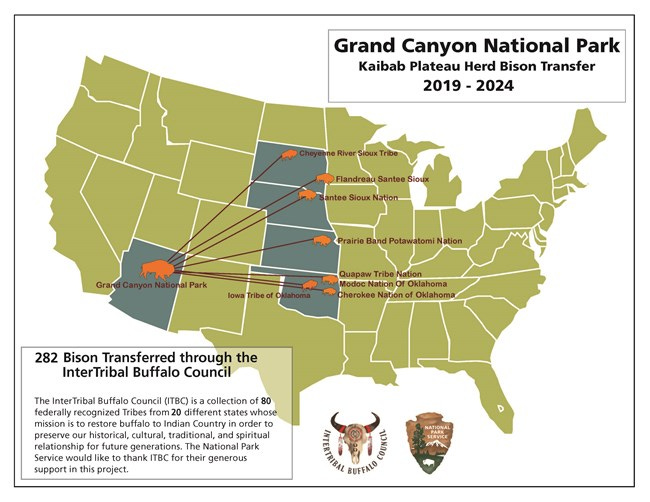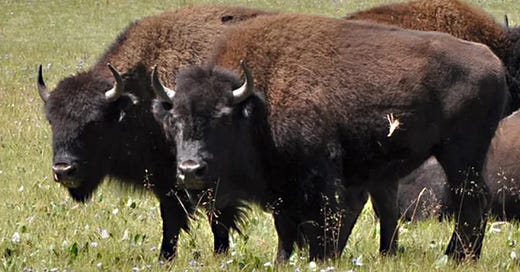Over a century ago, a herd of bison was transported to the Kaibab Plateau near the North Rim of the Grand Canyon. Today, the National Park Service has been working to keep the animals from overpopulating the area.

The American bison, a symbol of the American West, once roamed the grasslands and prairies of North America in vast numbers, estimated in the tens of millions. Their range extended from Alaska to northern Mexico. However, today they are found in only about 1 percent of their historical range. Their population was decimated to just a few hundred by the 1880s, although estimates vary.
Are Bison and Buffalo One and the Same?
Though the terms are often used interchangeably, buffalo and bison are different species. Old World “true” buffalo (Cape buffalo and water buffalo) are native to Africa and Asia. Bison are found in North America and Europe.
Although both bison and buffalo are in the bovidae family the two are not closely related even though they are both large, horned ox-like animals.
How did the names get so mixed up? It probably stems from confused European explorers. According to the National Park Service, it’s possible it stemmed from the French word boeuf, meaning beef. Whatever the case, the misnomer stuck, and we tend to use the two words interchangeably.

How Did Bison Get to Arizona?
Bison were once found in what is now Arizona many years ago however bison herds that currently reside in the Arizona Strip were imported last century.
In 1905, “Uncle” Jimmy Owens, from my last post, and frontiersman, Charles Jesse “Buffalo” Jones (1844-1919) imported a herd of bison from Yellowstone National Park where Jones had been working as the game warden, and Owens had been the “buffalo” keeper. The herd of bison was moved by train to the town of Lund in southern Utah, then they were herded to the Kaibab Plateau, a grassy, forested expanse on the Grand Canyon’s North Rim. Theodore Roosevelt set aside a portion of the Grand Canyon Forest Reserve as a wildlife refuge, where hunting was illegal.
Arizona Game & Fish Department managed the herd starting in 1929 at approximately 100 bison, in the House Rock Wildlife Area within the Kaibab National Forest. In the 1990s, due to public hunting pressure, drought, reduced forage and fire, about 100 bison migrated to Grand Canyon National Park’s North Rim. Since 2010, the herd has primarily resided on the North Rim within Grand Canyon National Park.
The Kaibab Plateau Bison Herd is physically separate from other Arizona wild bison herds (the House Rock Bison Herd and the Raymond Ranch Herd). It is currently co-managed by Grand Canyon National Park, Arizona Game & Fish Department, and the Kaibab National Forest
Reducing the Herd
In 2014, the National Park Service began a scientific planning process to address bison overpopulation in Grand Canyon National Park. By 2017, after collaborating with the public, the state of Arizona, and Native American tribes, and utilizing the best available science, park managers completed the Initial Bison Herd Reduction Plan. This plan seeks to decrease the bison population through live capture and relocation, complemented by selective culling.
Since reduction efforts began in 2018, park staff have removed 306 bison from the North Rim, with 282 transferred to eight different native American tribes through an agreement with the Intertribal Buffalo Council (even they use the incorrect name for the animals). According to their website the Intertribal Buffalo Council (ITBC) is a collection of 80 tribes in 20 different states that facilitates the management of over 20,000 buffalo.

The 2024 summer population estimate for the herd was approximately 378 animals. Based on the success of bison reduction efforts, lethal removal operations will not be necessary in 2024 to reach the park’s stated reduction goal. Grand Canyon National Park is attempting to reduce the size of the herd to under 200 animals in order to protect park resources such as vegetation, water, and sacred archeologic sites from the impacts of the bison.
September 13, Grand Canyon wildlife managers successfully relocated 100 bison from the North Rim of Grand Canyon. All bison were transferred to the ITBC.
How to Visit
The Kaibab Plateau bison herd usually spends their summers in the open meadows and near water sources where they are most likely to be viewed by the public. In autumn they range widely and are dispersed across their range.
Please be careful when encountering bison!
The following are rules enforced by the National Park Service:
Bison are wild animals and are unpredictable.
Maintain a distance of 100 feet (30 m or two bus lengths) from bison.
When the bison are within 100 feet (30 m) of the road, it is recommended to view them from inside a vehicle.
Please use established gravel or paved pull-outs to park vehicles completely off the roadway (all wheels right of the white line). Do not walk or park in the road.

Next Time
The past four posts have centered on the North Rim of the Grand Canyon and I haven’t thought about where I want to take us next. Any suggestions on what you’d like me to cover?







Jan, perhaps you have some archaeological knowledge/ findings of ancient bones. Or maybe about the meteor crater in Arizona.
Have you posted about Lake Powell? When I was growing up in Phoenix, my dream vacation was to go on a houseboat around Lake Powell (or to go in a gondola in the canals of Venice - it seems water was a big part of the fantasies for this former desert rat). Another idea is maybe some history of the Native peoples from that region. Or the Petrified Forest. Or the Painted desert. Or Mexican Hat. Looking forward, as always, to your next post. 😃